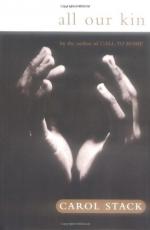
|
| Name: _________________________ | Period: ___________________ |
This test consists of 15 multiple choice questions and 5 short answer questions.
Multiple Choice Questions
1. What did those in the Flats usually call trading?
(a) Swapping.
(b) Borrowing.
(c) Bartering.
(d) Lending.
2. What is Viola Jackson's job?
(a) Janitor.
(b) Nanny.
(c) Cook.
(d) Maid.
3. How did people in the Flats refer to their friends and neighbors?
(a) By their first names.
(b) By their surnames.
(c) Kindly.
(d) By a nicknames.
4. Where did Stack meet the girl that introduced her to the families in the Flats?
(a) At her university.
(b) While babysitting for a friend.
(c) While doing laundry.
(d) In the grocery store.
5. Why did Stack change names and locations in the book?
(a) To protect identities.
(b) Because they asked her too.
(c) To keep them from getting kicked off welfare.
(d) To protect them from the mainstream.
6. According to Stack, what common belief do most studies of blacks reinforce?
(a) That they are unreliable.
(b) That they are unwilling to get ahead in life.
(c) Popular stereotypes.
(d) The status quo.
7. What are 63% of the black citizens in Jackson Harbor employed as?
(a) Teachers.
(b) Service workers.
(c) Caretakers.
(d) Maintenance workers.
8. How was Stack's car a hindrance to her?
(a) It caused the families to become dependent on her.
(b) It broke down constantly.
(c) It was unreliable.
(d) It was dangerous.
9. According to Stack, what do most studies of black families compare themselves to?
(a) White families.
(b) The status quo.
(c) Mainstream society.
(d) Their past culture.
10. According to the US Census, what percent of white deaths in 1965 were caused by diseases of infancy?
(a) 6.4.
(b) 4.6
(c) 1.3.
(d) 8.5.
11. How did Stack come in contact with the families she studied?
(a) Through a young woman in the community.
(b) She found them on her own.
(c) By befriending children.
(d) By holding a meet and greet.
12. What is the population of Jackson Harbor?
(a) 11,000.
(b) 18,000.
(c) 9,000.
(d) 15,000.
13. How did people in the Flats increase their social circle?
(a) Through swapping.
(b) Talking to new people.
(c) Making friends.
(d) Helping others.
14. What does AFDC stand for?
(a) Area of Future Development Construction.
(b) Aid to Fund Dependecy Collections.
(c) All of Future Dependency Construction.
(d) Aid to Families with Dependent Children.
15. What was the age range of most of the adults Stack studied?
(a) 20-50.
(b) 20-40.
(c) 30-60.
(d) 30-50.
Short Answer Questions
1. Who were welfare benefits designed to help?
2. How many other researchers had conducted studies in the Flats during the decade in which Stack conducted her study?
3. In what decade did Stack begin her study?
4. What affects a person's perception?
5. What is the name of Stack's son?
|
This section contains 393 words (approx. 2 pages at 300 words per page) |

|




